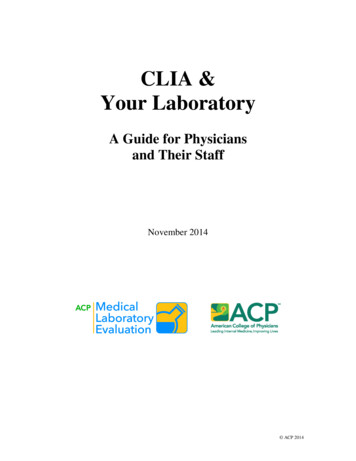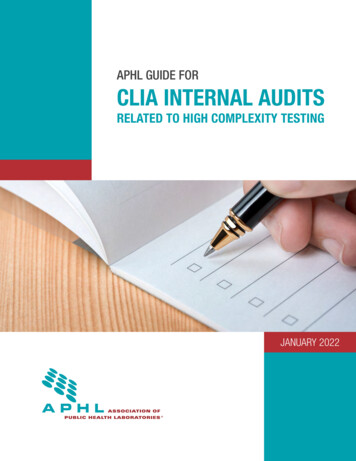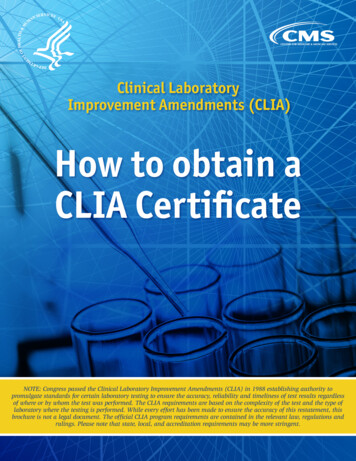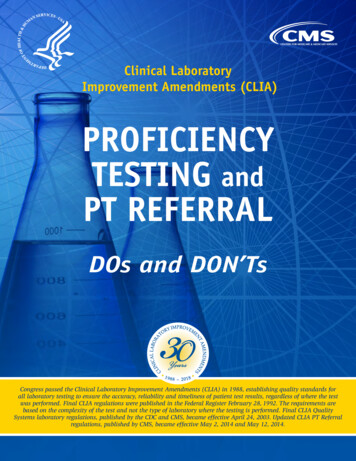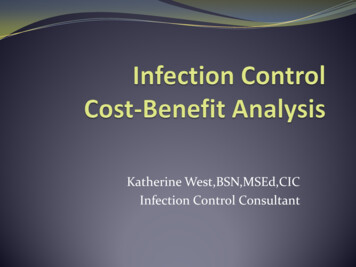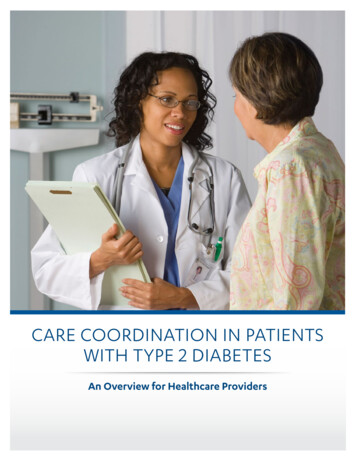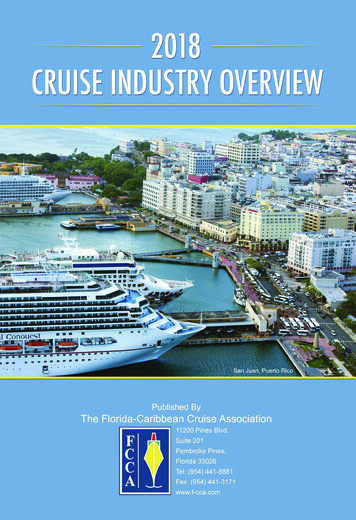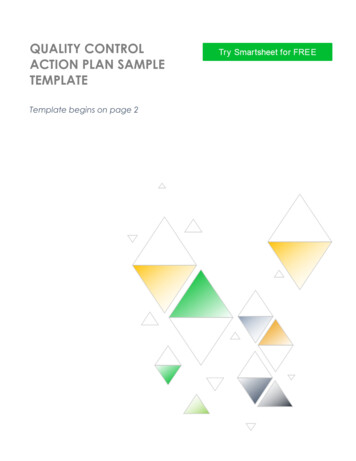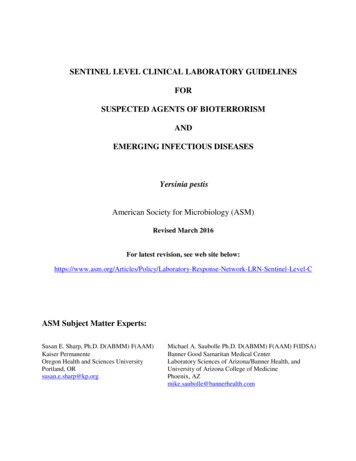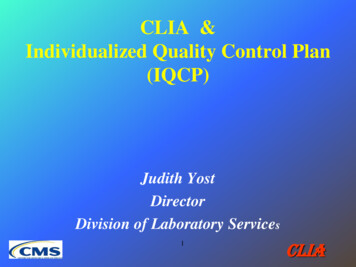
Transcription
CLIA &Individualized Quality Control Plan(IQCP)Judith YostDirectorDivision of Laboratory Services1CLIA
Objectives Provide Background & History of CLIAQuality Control Describe the Development of IQCP Present an Overview of Policies andInterpretive Guidelines related to IQCP Describe the Implementation Plan forIndividualized Quality Control Plan(IQCP)– Education & Transition Period2CLIA
In the Beginning .3
Quality Control Milestones .4
How does IQCP affect labs? Applies to CMS-certified non-waived labs Labs are already doing many of theseactivities, it’s just not formalized EQC will no longer be acceptable and willbe removed from the IGs IQCP does not have the same requirementsas EQC5CLIA
EQC vs. IQCPEQCIQCPTransitionalUpdated w scope/LimitedregulationsLimited specialtiesBroader scope/MoreregulationsAll but PathAnalyticPre Post AnalyticRequires Internal QCDecreases External QCDoes Not RequireInternal QCMay/may not decreaseQC6CLIA
7
The road to IQCP8
Creating IQCPIQCP gTeamAO/ES ationWorkgroup9
IQCP Planning Team CMS convened a planning team in 2011 tooversee the implementation of IQCP Team mbrs include CO, RO & formerdeputy div dir. w/ expertise in CLIA & labmedicine Planning team instituted WG’s tosimultaneously accomplish multiple tasksRO & SA TrainingCommunicationsInterpretive GuidelinesAO/ES re-approvalsEducation Outreach10
Individualized Quality ControlPlanPolicies & Regulations11CLIA
The Foundations of IQCP Includes key concepts from CLSI EP-23,“Laboratory Quality Control Based on RiskManagement” IQCP is not EP-23 Labs are not required to incorporate EP-2312CLIA
Where do we get our authority?493.1250 Condition: Analytic Systems HHS is permitted to approve a procedurewhich provides equivalent quality testingto meet the Analytic Systemsrequirements in 493.1251 – 493.128313CLIA
How is IQCP enforceable? IQCP is not a regulation, however IQCP will be an enforceable procedure forequivalent quality testing once published inAppendix C of the State Operations Manual EQC will no longer be acceptable and willbe removed from the IGs14CLIA
Mandatory vs. Voluntary IQCP is voluntary for laboratories Current CLIA control “default” regulationscontinue to be in effect EQC will be discontinued and will no longer be anacceptable QC option under CLIA15CLIA
Will IQCP reduce QC?IQCP is not intended to necessarily reduceQC requirements, but it is intended toensure effective QC for each laboratory andthe tests it performs.16CLIA
IQCP Facts Existing CLIA QC & quality system conceptswon’t change No regulations will change! State and local regulations still apply Lab director will continue to have overallresponsibility for QCP17CLIA
Laboratory Director ResponsibilitiesThe LD is responsible for: Accurate and reliable test results that areappropriate for patient care Ensuring that IQCP meets the requirements asset forth in IQCP Interpretive Guidelines Signing and dating the QCP whenimplemented and updated.18CLIA
Delegation of Duties by the LDThe LD may assign in writing: The responsibility for establishing IQCP aspart of the laboratory’s overall QC program tothe TC/TS Specific portions of IQCP tasks to otherqualified laboratory employees19CLIA
Grandfathering of CurrentSystems No grandfathering for current systems using EQC However, historical data may be used in thedevelopment of an IQCP At the end of the Education & Transition Period,all existing and new test systems must complywith IQCP or “default” CLIA regulations20CLIA
Manufacturer’s Instructions Laboratories performing non-waived testsmust follow all manufacturers instructions When the manufacturer’s instructions forQC are absent or less stringent than the“default” CLIA control procedures – the laboratory must choose to develop an IQCPor follow CLIA QC regulations21CLIA
Minimum QC Frequency CLIA will not set a minimum QCfrequency for labs performing IQCP However – Performing no QC is unacceptable– QC frequency can not be less than themanufacturer’s instructions– The RA & lab’s data must support the QCfrequency22CLIA
Specialties/SubspecialtiesAll CLIA specialties/subspecialties willbe included in IQCP, except.―Pathology―Histopathology―Oral Pathology―Cytology23CLIA
How do the regulations relateto IQCP? All CLIA regulations remain in force and mustbe followed Only the eligible regulations identified in thefollowing table(s) may be considered withIQCP Any IQCP eligible regulation that the labchooses to replace with IQCP must besupported in the RALet’s take24 a closer look .CLIA
Table 1: Eligibility for IQCPCLIA ationsEligible for IQCPSpecialty/SubspecialtyRegulationsEligible for IQCPSpecialty/SubspecialtyRegulationsNOT Eligiblefor (3)-(5)§493.1256(e)(1)-(4)§493.1265N/ASyphilis 93.1256(e)(1)-(4)N/AN/A25CLIA
Table 1: Eligibility for IQCPCLIA ationsEligible for IQCPSpecialty/SubspecialtyRegulationsEligible for IQCPSpecialty/SubspecialtyRegulationsNOT Eligiblefor IQCPRoutine 93.1256(e)(1)-(4)N/A§493.127626CLIA
Table 1: Eligibility for IQCPCLIA ationsEligible for IQCPSpecialty/SubspecialtyRegulationsEligible for IQCPSpecialty/SubspecialtyRegulationsNOT Eligiblefor (3)-(5)§493.1256(e)(1)-(4)§493.1278(b)(6), (c),(d)(6), (e)(3)§493.1278(a),(b)(1-5),(d)(15), (d)(7),(e)(1-2), (f),(g)PathologyNoNone (Not eligiblefor IQCP)N/AN/AHistopathologyNoNone (Not eligiblefor IQCP)N/AN/AOral PathologyNoNone (Not eligiblefor IQCP)N/AN/ACytologyNoNone (Not eligiblefor IQCP)N/AN/A27CLIA
Provider PerformedMicroscopy (PPM) procedures Definition of a PPM Is IQCP applicable to PPM procedures? Application of IQCP is test dependent– Reagents– Stains All CLIA regulations must continue to befollowed28CLIA
Interpretive GuidelinesIndividualized Quality ControlPlanIQCPRAQCP29QACLIA
Individualized Quality Control entIndividualizedQualityControl Plan30CLIA
Interpretive Guidelines IQCP- Introduction- Lab Director Responsibilities- Regulatory Considerations- RA- QCP- QA31CLIA
Risk Assessment - DefinitionRisk assessment is the identification andevaluation of potential failures andsources of errors in a testing process.(Interpretive Guidelines, Risk Assessment Section)32CLIA
Risk Assessment Identify and evaluate risks Risks are potential failures and sources oferror that can impact the accuracy andprecision of test results Risk assessment is the first step in riskmanagement33CLIA
Risk Assessment in IQCPAnalyticPreanaylticSpecimen Test SystemEnvironmentReagentsTesting PersonnelPostanalytic34CLIA
Risk Assessment in IQCP:Components5 Required Components: SpecimenEnvironmentReagentTest systemTesting personnel35CLIA
Risk Assessment in IQCP:Entire Testing ProcessMust consider the entire testing process: Pre-analytic Analytic Post-analytic36CLIA
Risk Assessment: I did it my way! The risk assessment for any given testsystem may look very different in differentlaboratories For example, the same risk may be assignedto different components by differentlaboratories37CLIA
Risk Assessment in IQCP: DataData requirements Laboratory’s own data required Can be new data or historical38CLIA
Laboratory: Risk Evaluation The laboratory evaluates the risks There are many methods to evaluate risks IQCP does not mandate any specificmethod of risk evaluation The laboratory must provide documentedevidence of the risk assessment39CLIA
Laboratory Risk EvaluationThe laboratory director must ensure thatthe risk assessment considers both theCLIA requirements for accurate testresults and the responsibility for ensuringthat test result quality is adequate forpatient care.40CLIA
Linking the RA to QCPAfter the lab has identified the sourcesof potential failures and errors for a testingprocess and evaluated the frequency andimpact of those failures and errors, theresulting RA is used to develop the QualityControl Plan (QCP). (Interpretive Guidelines, RiskAssessment Section)41CLIA
Quality Control Plan - DefinitionA QCP is a document that describes thepractices, resources, and procedures tocontrol the quality of a particular testprocess. (Interpretive Guidelines, Quality Control PlanSection)42CLIA
“I” Means IndividualizedCustomized/individualized QCP basedon lab’s specific circumstances (type oftesting (subspecialty/specialty), testvolume, availability of clinical info, testcomplexity, patient population &environment.43CLIA
The QCP Must Monitor over time the accuracy andprecision of test performance Include the number, type, and frequencyof QC Define criteria for acceptability of QC44CLIA
Other information to considerIf indicated by the evaluation of the risk assessment,the QCP may also include– electronic controls,– procedural controls,– training and– competency assessment,– other specified quality control activities45CLIA
Quality Assessment The laboratory must establish a reviewsystem for the on-going monitoring of theeffectiveness of their QCP. The monitoring should include at least thefollowing: testing personnel, environment,specimens, reagents, and test system.(Interpretive Guidelines, Quality Control PlanSection)46CLIA
QAWhen the laboratory discovers a testingprocess failure, the laboratory mustconduct and document an investigation toidentify the cause of the failure, its impacton patient care, and make appropriatemodifications to their QCP47CLIA
QAIf necessary, the laboratory must updatethe risk assessment with the newinformation and modify the QCP48CLIA
Education and Transition PeriodLook closer 49
Before Education & Transition Periodfor IQCP – CLIA Surveyors Principles of Risk Management at each divisionmeeting National Surveyor Training on IQCP –November 18 – 22, 2013 S&C 13-54-CLIA letter released August 16,2013 provides information, timelines andpolicy decisions.50CLIA
TimelineBegins: January 1, 2014Ends: January 1, 201651CLIA
Preparing for Implementationof IQCP - Laboratories IQCP Education & Transition (E/T) Period––––Two years longLearn about IQCP & ask questionsMake transition plansBegin to implement qc option if MI QCfrequency is less than current CLIA QCregulations52
Three Options for Complianceduring E&T period . Follow the CLIA regulatory QCrequirements as written Continue to follow the EQC proceduresas described in the current IGs Implement IQCP as described in S&C13-54-CLIA53CLIA
Timeline for Surveyors January 1, 2014: Surveyors will surveyaccording to instructions for Education andTransition Period (S&C Letter 13-54-CLIA) January 1, 2016: Surveyors will survey forcompliance with CLIA QC regulations orIQCP54CLIA
Timeline for Laboratories January 1, 2014: Laboratories may useCLIA QC regulations, EQC, or IQCP January 1, 2016: Laboratories must followCLIA QC regulations or IQCP55CLIA
During Educational and Transition(E/T) Period If a laboratory opts to use IQCP .– Surveys will be educational for labsimplementing IQCP, all other regulationsmust be met– Surveyors are directed to use a “DearLaboratory Director letter" to report anyfindings for IQCP related issues.56CLIA
Education & Transition Period forIQCP No control procedure regulatory citations will beissued prior to the end of the education &transition period unless serious test qualityproblems are found If Immediate Jeopardy is identified, deficiencieswill be cited.57CLIA
End of the Education andTransition Period The CLIA Interpretive Guidelines will berevised EQC will be REMOVED IQCP will be INSERTED58CLIA
After: E/T Period vs Implementation Implementation of IQCP– After January 1, 2016– The lab will have IQCP or default QCregulations– All new and existing test systems must bein compliance59CLIA
Education & Transition Period forIQCPAll questions regarding IQCP may be directed toour electronic mailboxIQCP@cms.hhs.gov60CLIA
Education & Transition Period forIQCP CMS has solicited accrediting orgs (AO) todetermine their interest in IQCP Adoption of IQCP “requirements” in AO/ESprograms is voluntary Accredited labs must continue to meet theiraccrediting org.’s QC standards61CLIA
To summarize . Once effective, IQCP will supersede thecurrent EQC policy Existing CLIA QC & QS concepts won’tchange No regulations will change! Minimally, labs must follow mfr’s. instructions Lab director has overall responsibility forQCP62
To summarize . IQCP Interpretive Guidelines - Introduction- Lab Director Responsibilities- Regulatory Considerations- RA- QCP- QA63
To summarize Education & transition period for labsbefore IQCP is fully effectiveBegins: January 1, 2014Ends:January 1, 2016 Info & Guidance on IQCP can be found at.www.cms.hhs.gov/clia/64
Questions about IQCP?All questions regarding IQCP may be directed toour electronic mailboxIQCP@cms.hhs.gov65CLIA
CLIA website - gislation/CLIA/Individualized Quality Control Plan IQCP.html66CLIA
Where to Obtain InformationCMS/CLIA Web site:www.cms.hhs.gov/clia/S&C: o/Downloads/Survey-and-Cert-Letter-13-54.pdfCMS CLIA Central Office:410-786-3531Judy Yost’s email:Judith.yost@cms.hhs.govIQCP Link:IQCP@cms.hhs.gov67CLIA
THE END!!Thank You!!!68CLIA
IQCP will be an enforceable procedure for equivalent quality testing once published in Appendix C of the State Operations Manual EQC will no longer be acceptable and will be removed from the IGs 14 CLIA Mandatory vs. Voluntary IQCP is voluntary for laboratories Current CLIA control "default" regulations continue to be in effect
